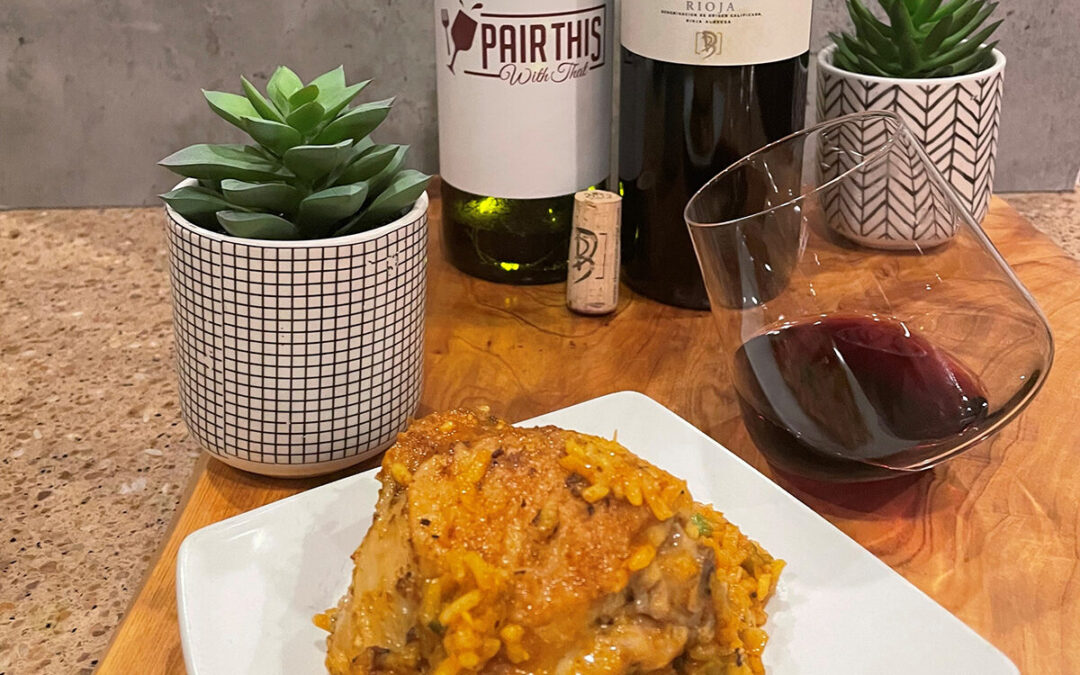It’s the first official Pair This With That blog post. Oooh! Are you trembling with excitement?
I wanted to make sure I had something of substance for the inaugural post – something I never made before, but seemed perfect for me in terms of flavors and style of food.
Caribbean Delight
The lucky dish? Cuban Rice and Chicken (more commonly known as arroz con pollo).
It’s a recipe that, at first glance, was a little bit involved, but not too daunting. The best part about it is that bone-in chicken thighs are the main component. I love chicken thighs because you can buy a lot of them for a really affordable price!
Plus the semi-Latin American, semi-Caribbean flavors seemed right up my alley.
Before I started cooking, it was prep time.
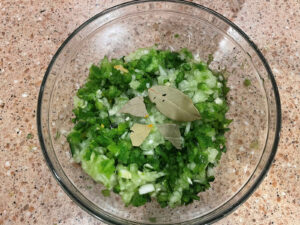 I sprinkled the chicken thighs with two teaspoons of cumin, salt, and pepper. Next, I chopped up:
I sprinkled the chicken thighs with two teaspoons of cumin, salt, and pepper. Next, I chopped up:
- 1 medium yellow onion
- 1 medium bell pepper
- 1 poblano pepper
All of these went into a bowl along with:
- 4 cloves garlic, minced
- 1 tsp ground turmeric
I mixed everything together and added two bay leaves.
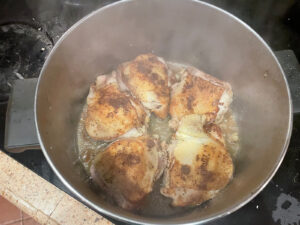 On the stovetop, I heated up a stockpot on medium-high heat and swirled in two tablespoons of olive oil. When ready, I put the chicken in skin side down. The chicken cooked for 12 minutes, turning over once.
On the stovetop, I heated up a stockpot on medium-high heat and swirled in two tablespoons of olive oil. When ready, I put the chicken in skin side down. The chicken cooked for 12 minutes, turning over once.
When the chicken was done, I put it aside on a plate. As the stockpot continued to heat, I put in the ingredients I had prepared before, along with an 8-ounce can of tomato sauce and 1 teaspoon of cumin. I stirred this mixture for about three minutes, then added 1-1/2 cups of white long grain rice, 1 cup of beer, and 1-1/2 cups of chicken broth.
I stirred up everything, placed the chicken thighs on top of the rice mixture, covered the pot, and let it simmered for about 20 minutes.
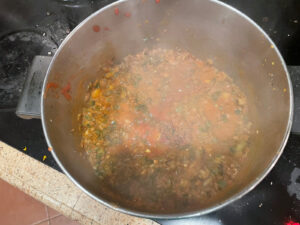
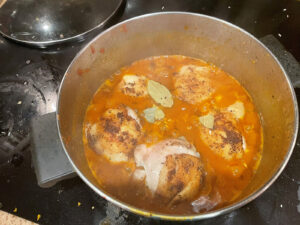 After 20 minutes, I stirred in 1 cup of thawed frozen peas and cooked for another five minutes.
After 20 minutes, I stirred in 1 cup of thawed frozen peas and cooked for another five minutes.
When it was ready, I let everything rest for about 10 minutes before serving, then plated with a handful of chopped cilantro for each dish.
The experience was delicious – with rich, thick textures, tender chicken, and Caribbean flavors. The recipe sounds a little involved, but it wasn’t tedious at all. When something comes out this flavorful and delicious, it’s worth the effort you put into it.
The Wine: 2013 Dominio de Berzal Rioja
 To go with this dish, I selected a 2013 Dominio de Berzal Rioja. The first instinct with something that has chicken as its main component and a style that MIGHT possess a bit of spicy kick to it, is to pair it with a crisp white.
To go with this dish, I selected a 2013 Dominio de Berzal Rioja. The first instinct with something that has chicken as its main component and a style that MIGHT possess a bit of spicy kick to it, is to pair it with a crisp white.
But the fattiness of the thigh, along with the more subdued but robust Caribbean flavors made this a great match. It was tasty medium-bodied red with a harmonious balance of flavors.
The wine was 95% Tempranillo and 5% Graciano. On the nose and the palate, there were notes of red cherry and dried fig, along with subtle undertones of cedar and tobacco. This was a ten-year-old vintage, so any tannins it had when it was young had dissipated, providing a smooth and approachable drinking experience.
About Dominio de Berzal
The history of this winery dates back to 1958. Dominio de Berzal is the dream of three brothers: José Luis, Juan Mari and Iñigo Berzal. Together we took over from our father and founded the current winery in 1999, located in Baños de Ebro (Álava), in the heart of Rioja Alavesa.
In 1999 Dominio de Berzal was given the label of Crianza, establishing the winery we know today. José Luis Berzal Martínez, passed on his passion to his family at a very young age, and they’ve carried on his traditions and the essence of his life: love for the land and the courage to pursue your own dreams.
About the Rioja Region
The distinct characteristics of the Rioja region plays a significant role in influencing the flavors and aromas of the wines produced there. The diverse landscape, which includes a mix of elevations, soils, and microclimates, contributes to the complexity and uniqueness of Rioja wines. Here’s how the topography influences the characteristics of wines from this region:
Rioja features a range of altitudes, with vineyards situated at different elevations. The altitude affects temperature variations, influencing the ripening process of grapes. Higher altitudes often lead to cooler temperatures, resulting in slower ripening and the development of more nuanced flavors in the grapes. Wines from higher-altitude vineyards may exhibit greater acidity and freshness.
In addition, Rioja’s topography includes a variety of soil types, such as limestone, clay, and alluvial deposits. Different soil compositions contribute distinct mineral characteristics to the wines. For example, vines planted in limestone-rich soils may produce wines with a mineral or chalky quality, while clay soils can enhance body and structure.
The diverse topography creates microclimates within the region, allowing for the cultivation of various grape varieties. The combination of warm days and cool nights in some areas can lead to a longer growing season, promoting the development of complex flavors and aromas in the grapes.
Exposure to sunlight and the Ebro River contributes to the region’s vineyards located having a moderating influence on temperatures. This can result in a more temperate climate, influencing the balance and freshness of the wines.
First blog post on Pair This With That, and I think I did it justice with an outstanding meal and a kick-ass wine pairing. What do you think? Any other pairing you might have tried with this dish? Let me know in the comment section below.
Cheers!

